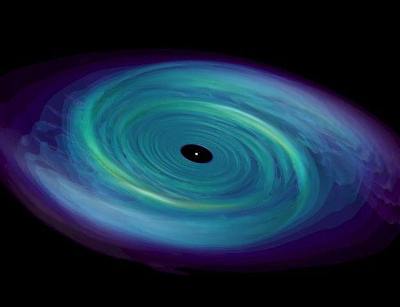White Star
 _________________________________________
_________________________________________Dwarf or White Star graphic by uwec edu Physics 315
The graphic shows spiral shock waves in a three dimensional simulation of an accretion disk -- material swirling onto a compact central object that could represent a white dwarf star, neutron star, or black hole. Such accretion disks power bright x-ray sources within our own galaxy. They form in binary star systems which consist of a donor star (not shown above), supplying the accreting material, and a compact object whose strong gravity ultimately draws the material towards its surface.
New observations are shedding light on how black holes acquire mass. Black holes have a bad reputation for sucking in entire galactic neighborhoods. Yet unlike Wall Street and other earthbound black holes, their evil clutches only reach so far.
After all, gravity's strength is determined by mass and distance. If the Sun suddenly collapsed into a black hole, Earth would keep right on orbiting. We wouldn't suddenly fall in. A year would still be 365 days, however chilly.
Scientists really don't know how matter spiraling around a black hole in an accretion disk suddenly plunges into the void. Like a planet around a star, matter in an accretion disk will orbit a black hole until it loses its angular momentum. Is matter closest to the black hole pushed in by incoming matter? Do magnetic fields, torque, or radiation pressure create instabilities in the disk, causing the matter to spiral inward? New observations of accretion disks are providing insight.
Regardless of size, black holes easily acquire accretion disks. Supermassive black holes can feast on the bountiful interstellar gas in galactic nuclei. Small black holes formed from collapsing stars often belong to binary systems in which a bulging companion star can spill some of its gas into the black hole's reach. In the chaotic mess of the accretion disk, atoms collide with one another. Swirling plasma reaches speeds upward of 10% that of light and glows brightly in many wavebands, particularly in X-rays. Gas gets blown back by a wind of radiation from the inner disk. New material enters the disks from different directions.
"We know that all the material can't possibly behave itself in a nice, orderly fashion," says Ian George of the University of Maryland, Baltimore County (UMBC). But what is perplexing, says George, is the regularity of some systems, where the disk can empty into the black hole as if on cue.
Black holes often shoot out jets of material
perpendicular to their accretion disks.

Alan Marscher of Boston University has monitored one supermassive black hole that sucks in and squirts out matter at regular intervals. About every 10 months, Marscher found that the inner accretion disk around a black hole in galaxy 3C120 disappears as jets of matter shoot out from the black hole perpendicular to the disk. "Slowly the accretion disk will fill with more interstellar gas until about 10 months later, when something disturbs the accretion disk orbit, and the whole thing flushes and blows again," says Marscher.
________________________________________________
Image and text from NASA Solar System
But what causes this flushing? A few years back, scientists spotted the same process in a nearby stellar black hole system called GRS 1915+105, dubbed the Old Faithful Black Hole. Here, steady, incoming gas from a companion star adds enough matter to the outer disk to cause the entire inner disk to dump over the event horizon.
For supermassive black holes, there is no single, steady source to ensure regularity. One would think the flow should be random. John Hawley of the University of Virginia has developed models and computer simulations of disk instabilities for a variety of black-hole systems. He proposes that large systems possess thermal instabilities, which could lead to regularity.
These huge accretion disks, often spanning well over a light-year, vary greatly in density and temperature from the outer to inner edges. Like a weather system following the physics of high- and low-pressure currents, pools of plasma might form in specific regions, giving the matter in the inner disk that final, fatal push.
Jane Turner of UMBC, along with George and several others, may have spotted a prime source of this disk instability: breaks in magnetic fields at specific radii away from the black-hole event horizon. In June, Turner published the results of a dual observation with NASA's Chandra X-Ray Observatory and ESA's XMM-Newton satellite of a supermassive black hole in galaxy NGC 3516. Her team found evidence of X-ray flaring in the accretion disk at distances of 35 and 175 times the black-hole radius.
The flares are likely caused by a snap in the black hole's magnetic field as the disk swirls. These snaps stress the accretion disk, creating hot spots and ripples that perhaps ultimately churn to tidal waves in the disk, sending matter screaming into the black hole. "Observations such as these might be providing our first glimpse of the structure of a real accretion flow," says George.
More detailed observations will surely come through the exquisite resolution afforded by the new generation of X-ray telescopes and the Very Long Baseline Array, a continent-wide string of radio telescopes.
Scientists need to study a variety of black holes big and small, bright and dim, voracious and dieting to understand the observed disparity in accretion flows. In the end, crazy black hole accretion might be more predictable than the stock market.
______________________________________________________
"For everyone, as I think, must see that astronomy compels the soul to look upwards and leads us from this world to another." Plato
_______________________________________________________
For further reading please visit:
Quantum character of blackholes by Adam D Helfer
strangelets-do-not-exist by Plato
Properties of nuclear matter at high densities by Columbia University
_______________________________________________________
_______________________________________________________
Labels: Astro Physics, Theoretical Physics, White Star


<< Home